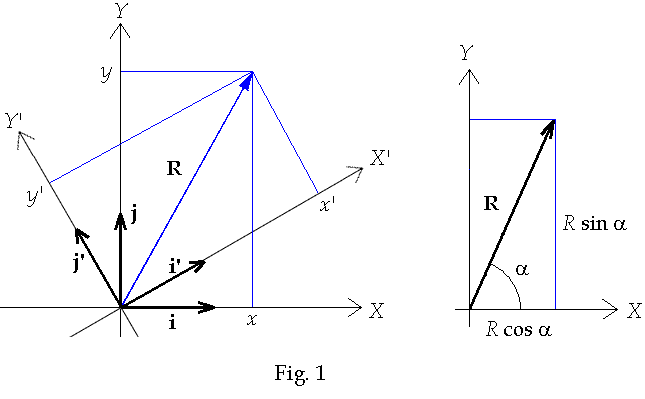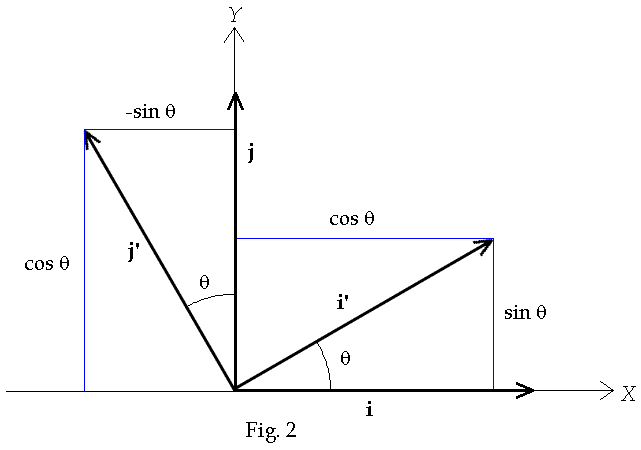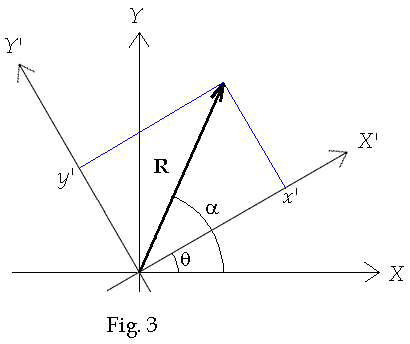Invariance
Back
to Physics World
Back
to Geometrical Math for GR
Certain
quantities remain unchanged by a change in coordinates and thus in a change in
basis vectors as well. Let the old coordinates of the point P be xb
and the new coordinates be
![]() where
where
![]()
Note: In
this page the subscripts and superscripts will be Greek letters. These values
will take on the same number of integers as the dimension of the manifold. In
relativity the dimension of the manifold may be four. Consider the function F(xb).
If, upon a change of coordinates,
![]()
and the
basis changes with the change in coordinates then F is called a scalar,
an invariant or a tensor of rank zero. The change F
Þ F’
means only that the function has a different functional form in the new
coordinates. But the mapping from point to real numbers remains unaltered. An
example of a scalar is the scalar product of two vectors. Let A
and B be two vectors. Then the scalar product is represented as
![]()
where gab
are the components
of the metric tensor. Summation is implied over the valid range of the
subscripts and superscripts. Am
are the contravariant components of A and Bm
are the covariant
components of B. It A
and B are general vectors then, by definition

where,
for an allowable coordinate transformation
![]()
where
![]() is
called the Kronecker delta and has the value of 1 when the arguments
(i.e. the superscript/subscript) and zero otherwise. Substitution of these
values into Eq. (3) gives
is
called the Kronecker delta and has the value of 1 when the arguments
(i.e. the superscript/subscript) and zero otherwise. Substitution of these
values into Eq. (3) gives

It
should be noted that the components of a vector are not scalars. However there
is a caveat to this that should be explored. Consider vectors in Euclidean
geometry. For simplicity we restrict our attention to examples where all the
vectors are in a plane. In Cartesian coordinates the metric tensor is the
Kronecker delta and the covariant components equal the contravariant components.
Any vector can be expressed in terms of a set of basis vectors. The unit vectors
i and j take on their usual meaning, i.e. they are vectors of unit
length pointing in the positive direction of the x-axis and y-axis
respectively. We will consider vectors in two coordinate systems, one that is
rotated relative to the first where the unit vectors in the rotated system point
along the x’-axis and the y’–axis and are labeled i’
and j’ respectively. Any vector R can be expressed in either
coordinate system. For example: R can be written as
![]()
See Fig.
1 below

or as
![]()
Given
any two Euclidean vectors A and B it can be shown that
![]()
In Eq.
(9) A and B are the magnitudes of the vectors A and B respectively
and f
is the angle between the two vectors. It follows that

Here is
the caveat mentioned above. While x and y are the components of
the vector R and the components of a vector change upon change in the
coordinate system it also follows that x and y are the values of
two scalar products and are therefore invariant with respect to a coordinate
transformation. To be precise, x will not change with a change of
coordinates since x is the projection of R in the direction of i
and this has an invariant meaning. The
vector i does not change upon a change of coordinates. The reason
is as follows: Both R and i are vectors and as such the scalar
product of these two vectors is an invariant, in this case the invariant is the
value x. This means that if both R and i are expressed in
terms of components of another coordinate system then the dot product will
remain unaffected. Graphically this means that the dot product of R and i
has the value of the component in the direction of i that is therefore a
quantity which is coordinate independent. As can be seen from Fig. 2

i’ and j’ can be expressed in terms of i and j basis vectors as
![]()
Solving
Eq. (11) for i and j in terms of i’ and j’ gives

R
can be expressed in terms of the new coordinate system as shown in Fig. 3 below
(The unit vectors are not drawn to keep the diagram from being too cluttered).

In
the new coordinates the R is written as
![]()
Therefore

In
special relativity there is a similar situation. Let the 4-momentum of a
particle be
![]()
where m
is the mass of the particle and E = mc2
is the free-particle energy. Let the 4-velocity of a particular observer be
![]()
where
vobs is
the 3-velocity of the observer and
![]()
Consider
the quantity
![]()
If we
choose to evaluate these quantities in the rest frame of the observer then
![]()
where e0
is a 4-vector pointing in the direction of increasing time as measured in the
rest frame of the observer. Using Minkowski coordinates (t, x, y, z) the
metric tensor becomes hmn = diag(1, -1,
-1, -1). Using these the scalar productt in Eq. (17) becomes
![]()
Thus in
this context m is an invariant. It’s referred to as the “mass
measured by observer” and as such there is no ambiguity to the value of
mobs
since all agree on
what observer measures. The time component of the 4-momentum of a
particle is the mass as measured by the observer of the current frame. That too
is unique if we keep in mind that the frame itself has an identity all its own.
Without the subscript m refers to the current frame observer.